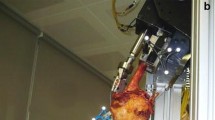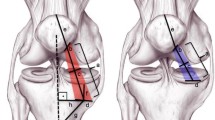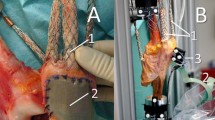Abstract
Purpose
The influence of the medial patellar ligamentous structures on patellar tracking has rarely been studied. Thus the main purpose of this cadaveric biomechanical study was to determine the influence of the medial patellofemoral (MPFL), medial patellomeniscal (MPML) and medial patellotibial (MPTL) ligaments on the three-dimensional patellar tracking during knee flexion. This study was conducted using a validated cadaveric optoelectronic protocol for analysis of patellar kinematics.
Methods
For each cadaveric knee study, four successive acquisitions were performed; first was studied patellar tracking in healthy knees, then the junction between MPFL and vastus medialis obliquus (VMO) was sectioned, the MPFL was released at its patellar attachment and finally was released the insertion of the MPML and MPTL.
Results
In this study, the MPFL accounts for 50–60% of the medial stabilization forces of the lateral patellar shift during patellar engagement in the femoral trochlea. This work confirm and clarify the role of the MPFL as the primary stabilizer of the patella during the initial 30° of knee flexion. Moreover, this study shows no significant results regarding the stabilizing action of the VMO on the patella during knee flexion.
Conclusion
This in vitro study, conducted with an experimental protocol previously validated in the literature, helps quantify the actions of the MPFL, the VMO, and the MPML/MPTL respectively, and identify areas of joint motion where these structures have the most significant influence. This confirms the importance of reconstruction in the treatment of chronic patellar instability. During its reconstruction, care should be taken to adjust the MPFL balance during the initial 20°–30° of flexion.



Similar content being viewed by others
References
Amis AA, Firer P, Mountney J, Senavongse W, Thomas NP (2003) Anatomy and biomechanics of the medial patellofemoral ligament. Knee 10:215–220
Arendt EA, Fithian DC, Cohen E (2002) Current concepts of lateral patella dislocation. Clin Sports Med 21:499–519
Bull AM, Katchburian MV, Shih YF, Amis AA (2002) Standardisation of the description of patellofemoral motion and comparison between different techniques. Knee Surg Sports Traumatol Arthrosc 10:184–193
Conlan T, Garth WP, Lemons JE (1993) Evaluation of the medial soft-tissue restraints of the extensor mechanism of the knee. J Bone Joint Surg Am 75:682–693
Desio SM, Burks RT, Bachus KN (1998) Soft tissue restraints to lateral patellar translation in the human knee. Am J Sports Med 26:59–65
Drez D, Edwards TB, Williams CS (2001) Results of medial patellofemoral ligament reconstruction in the treatment of patellar dislocation. Arthroscopy 17:298–306
Goh JC, Lee PY, Bose K (1995) A cadaver study of the function of the oblique part of vastus medialis. J Bone Joint Surg Br 77:225–231
Grood ES, Suntay WJ (1983) A joint coordinate system for the clinical description of three-dimensional motions: application to the knee. J Biomech Eng 105:136–144
Hautamaa PV, Fithian DC, Kaufman KR, Daniel DM, Pohlmeyer AM (1998) Medial soft tissue restraints in lateral patellar instability and repair. Clin Orthop Relat Res 349:174–182
Heegaard J, Leyvraz PF, Curnier A, Rakotomanana L, Huiskes R (1995) The biomechanics of the human patella during passive knee flexion. J Biomech 28:1265–1279
Henry JH, Craven PR (1981) Surgical treatment of patellar instability: indications and results. Am J Sports Med 9:82–85
Katchburian MV, Bull AM, Shih YF, Heatley FW, Amis AA (2003) Measurement of patellar tracking: assessment and analysis of the literature. Clin Orthop Relat Res 412:241–259
Nakagawa K, Wada Y, Minamide M, Tsuchiya A, Moriya H (2002) Deterioration of long term clinical results after the Elmslie–Trillat procedure for dislocation of the patella. J Bone Joint Surg Br 84:861–864
Panagiotopoulos E, Strzelczyk P, Herrmann M, Scuderi G (2006) Cadaveric study on static medial patellar stabilizers: the dynamizing role of the vastus medialis obliquus on medial patellofemoral ligament. Knee Surg Sports Traumatol Arthrosc 14:7–12
Philippot R, Chouteau J, Testa R, Moyen B (2010) In vitro analysis of patellar kinematics: validation of an opto-electronic cinematic analysis protocol. Knee Surg Sports Traumatol Arthrosc 18:161–166
Raimondo RA, Ahmad CS, Blankevoort LB (1998) Patellar stabilization: a quantitative evaluation of the vastus medialis obliquus muscle. Orthopedics 21:791–795
Reider B, Marshall JL, Ring B (1981) Patellar tracking. Clin Orthop Relat Res 157:143–148
Yamada Y, Toritsuka Y, Horibe S, Sugamoto K, Yoshikawa H, Shino K (2007) In vivo movement analysis of the patella using a three-dimensional computer model. J Bone Joint Surg Br 89(6):752–760
Author information
Authors and Affiliations
Corresponding author
Rights and permissions
About this article
Cite this article
Philippot, R., Boyer, B., Testa, R. et al. The role of the medial ligamentous structures on patellar tracking during knee flexion. Knee Surg Sports Traumatol Arthrosc 20, 331–336 (2012). https://doi.org/10.1007/s00167-011-1598-6
Received:
Accepted:
Published:
Issue Date:
DOI: https://doi.org/10.1007/s00167-011-1598-6




